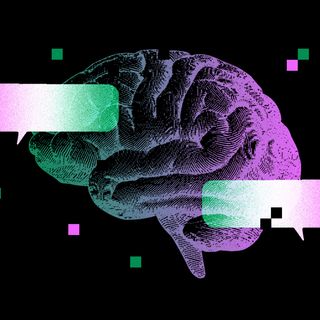
From ‘Smart Graveyards’ to Griefbots, Is Digital Immortality the Future of Death?
Death tech’s pursuit of “digital immortality” is reshaping how we process loss.

In The Future Of, we unpack technology’s growing influence on our lives to answer the pressing question — What lies ahead?
Below a single word epitaph that reads “Adapt,” Dr. Iwin Francis’ gravestone in Thrissur, Kerala bears a peculiar marker in remembrance of the 26 years of his life – a QR code. Scan the code, and it takes you to an audio-visual profile documenting the young doctor’s passions and achievements – a webpage studded with his musical performances, college programs, and photographs of him and his friends. The virtual memorial for Francis is meant for all those who happen upon his tombstone when there is no one available to tell them about him, his father told PTI. “Now, they can just scan the QR code and can know what sort of a person Ivin was.”
Francis’ gravestone isn’t the only one to bear this form of memorialization that bridges death rituals with modern technology. Since 2012, tech companies across the world have been offering such services, where families can create web pages dedicated to commemorating the lives of their loved ones.
There are innovators who will turn the deceased’s ashes into vinyl records that play their voice recordings, favorite music, or read out their will, while others promise to transform one’s ashes into memorial diamonds and wearable jewelry. Several companies are helping families with more practical worries – shutting accounts, ending subscriptions, and working through the legalities that follow in the immediate aftermath of a death. Then there are those who are undeterred in their aim to achieve a semblance of immortality and solve what they consider as the “problem” of death. Death care services alone are estimated to be a US $189.8 billion global industry by 2030. And when it comes to death tech, the tombstone bearing a QR code is only the tip of the iceberg.
For one, we already have virtual graveyards.
Even before companies began offering QR codes on gravestones, people continued to exist online well after their deaths. A version of their lives is preserved in their “digital remains” – likes, comments and images on social media platforms, and more generally, in their digital footprints. The proliferation of online accounts of the dead has been noted by several researchers. For instance, a 2019 paper by the Oxford Internet Institute (OII) predicted that the dead are overtaking Facebook, with the number of profiles of those deceased set to grow in millions in the next few decades. On this platform, the authors noted, “The dead may well outnumber the living before the end of the century…”
Our dependence on technology has already changed how we grieve. Facebook now allows accounts of the deceased to be memorialized. The “continuing bonds” theory explains the significance of this, according to Wendy Moncur, a professor at the University of Dundee. It says that people’s relationships with the deceased does not entirely end upon their death, but continues instead in a different form. “What we’re seeing is that conversation playing out on social media, rather than internally or someone standing at a graveside and having a chat with a headstone,” Moncur said.
Facebook’s virtual graveyard could serve a sociological, and historical purpose as well, according to the OII study. Lead researcher Carl Ohman told France24 that this could be “a collection of information that has both sentimental and historical value for future generations.” However, Ohman also flagged, “In this digital age, historical data and, more broadly speaking, the human memory is increasingly in the hands of a few technological empires that respond to profit-seeking logic above all.” This orientation towards profit would end up determining who, and what, is preserved.
Related on The Swaddle:
Scientists Revive Cells, Organs in Dead Pigs — Hinting at the Possibility of ‘Reversible Death’
Even using QR codes on tombstones that create digitally-linked “smart graveyards” could be important tools to decode history and map genealogies in the future, wrote Tamara Kneese in The Atlantic. But there’s a practical issue that arises when it comes to using software for memorialization purposes – the problem of obsolescence that becomes a threat to one’s legacy. While the aim is to keep a person, and their memories, alive in some form, software itself is not eternal.
The OII paper noted that digital information is “more fragile than is sometimes assumed… File formats change, hardware must be updated, and data needs to be continuously stewarded and organized in order to remain useful.” Both Facebook and QR codes suffer from the same uncertainties around software relevance. But as tech evolves, new forms of tech-assisted grieving are becoming possible.
Griefbots turn the dead into an ageless companion you can never touch.
With the advent of artificial intelligence comes the rise of grief bots – programs that take the deceased’s online data – messages, emails, posts, and search histories – and use them to create a digital replica of the deceased. Friends, family members and others grieving the dead can now converse with their avatar through these chatbots. These personalized bots will even attempt to imitate the deceased’s tone and patterns of communication.
These bots are attempting to achieve a form of “digital immortality.” More sophisticated chatbots can even allow the person’s digital avatar to evolve over time by keeping up-to-date with contemporary events and acquiring opinions of its own. In this way, the dead can become a new entity based on who they were, rather than just a replica of what the person was like at the time of death, Hossein Rahnama, who has been working on one such chatbot, explained to Quartz. Privacy, however, remains a concern here too – how much of the information that one hadn’t revealed while alive could become common knowledge after they are dead? Such technology has the ability to completely reshape a person’s legacy and how they are remembered.
When it comes to processing loss, some say grief bots could alleviate much of the distress by allowing people to communicate directly with the dead, helping them ease into accepting that a loved one is gone. Andrea Warnick, a grief counselor and thanatologist, told Quartz these chatbots can be therapeutic as they would help facilitate conversations about the dead – a topic that otherwise breeds hesitations.
However, many disagree, pointing to the several ethical and legal concerns that emerge with attempting to simulate the dead. AI could end up triggering painful memories for those dealing with a traumatic death or keep people from moving on, experts told The Daily Beast. “If you have a lot of contact with something… [but] you don’t have this awareness that [para-social relationships] can happen, you might end up with a relationship that actually keeps you from grieving the loss of that person,” said Pamela Rutledge, director of the Media Psychology Research Center.
Dr. Kirsten Smith, Clinical Research fellow at the University of Oxford, told Euronews Next, “There is evidence from multiple studies that proximity seeking [behaviours aimed at restoring a closeness with the person who died] is actually linked with poorer mental health outcomes… Proximity seeking behaviours may block someone forging a new identity without the deceased person or prevent them from making new meaningful relationships. It might also be a way of avoiding the reality that the person has died – a key factor in adapting to the loss.”
Such death-bots could thus not only violate the dignity of the deceased, but also end up negatively affecting the emotional and psychological well-being of those grieving. They’re not yet in wide use, though experimentation is ongoing and many predict that it could become a common feature in the grieving process. A 2022 paper thus highlights the need to regulate such deathbots. As of now, “Everyone who can implement a deathbot is allowed to program, use and sell deathbots,” it noted, adding that a possible way to overcome ethical quandaries would be to institute these as medical devices for the treatment of Prolonged Grief Disorder. This would require these bots to go through several stages of testing and restrict their usage, and in turn their possible negative effects.
Related on The Swaddle:
When Talking About Death Is Taboo, How Can Grieving People Heal?
Some are opting to be frozen after death.
At the Alcor Life Extension Foundation, Arizona – reportedly the world’s leading facility for cryonics – around 200 bodies lie suspended in liquid nitrogen, waiting for a time when medical technology advances to a point that it becomes possible to revive them. According to MIT Technology Review, around 4,000 people are on waitlists of cryogenic facilities around the world.
Cryonics, according to Alcor, is “the practice of preserving life by pausing the dying process using subfreezing temperatures with the intent of restoring good health with medical technology in the future.” The first person to be frozen was James H. Bedford in 1967, a psychologist who died of kidney cancer. His body is one of those preserved at Alcor.
However, many in the scientific community have expressed their skepticism of the claims made by cryogenic researchers. Theory doesn‘t always translate to reality, and freezing a brain’s structure, according to Dayong Gaom – a cryobiologist and professor at the University of Washington – does not mean its complex functioning will be preserved. Clive Coen, a professor of neuroscience at King’s College London, ridiculed these claims as well. Coen told The Guardian in 2016, “The main problem is that [the brain] is a massively dense piece of tissue. The idea that you can infiltrate it with some kind of anti-freeze and it will protect the tissue is ridiculous.”
If we hypothetically assume that it will become possible in the future to bring a frozen person back to life, there are other questions that emerge, as documented by BBC Future: What kind of society will these people be entering? How will they adjust? What about those who only have their heads preserved and must now adapt to a completely new body? How will they practically support themselves in the future?
“Even for someone extremely resilient, the need to adapt themselves to a new body, culture and environment seems extremely challenging… These people would be forced to ask themselves, ‘Just who am I, really?’” Jeffry Kauffman, a psychotherapist told BBC Future.
Most recently, billionaire Peter Thiel revealed that he had signed up to be cryogenically frozen after his death, so as to be resuscitated in the future. Thiel too, however, added that the tech “isn’t there yet.” “I don’t necessarily expect it to work, but I think it’s the sort of thing we’re supposed to try to do.” Cryonics is replete with ‘what-ifs’.
It all boils down to the debate around immortality, one that has been raging for decades. Several predictions have been made over the years about if, and when, humans will achieve immortality. One of the most sensational predictions – that humans will achieve immortality by 2030 – was made by futurist and former Google engineer Ray Kurzweil. But cryonics is not the only method to try.
Related on The Swaddle:
Scientists Are Finding Ways to Reverse Ageing. Is It Worth It?
And others want to upload their mind on the cloud.
It is the tech elite, who view death as a problem to be solved, who are the biggest proponents of a future where we can slow down aging and even avoid, or reverse, death by transcending the limitations of our bodies.
This quest for immortality takes myriad forms – there’s tech billionaire Bryan Johnson who has been receiving blood transfusions from his teenage son in an effort to look 18; there are researchers working on rejuvenation and anti-ageing technology; and then there are the transhumanists who say we should harness technology to surpass biological limitations and create a post-human species. One of the proposed solutions is mind uploading, a concept that says we can upload our consciousness into a computer and live forever.
The possibility that we will one day be able to digitize our brains has fascinated futurists. Scientist Robert McIntyre even launched a startup, Nectome, in 2015 that embarked upon a journey to preserve brains in anticipation. To do this, the company created an embalming chemical solution that would be injected into people while still alive, preserving their brains so it can be “scanned and uploaded” when technology becomes available. However, Nectome soon ran into trouble when a 2018 MIT Technology Review article underlined the fact that the company was planning to work with terminally ill patients, since brain preservation is a “fatal” process – “you have to be euthanized first.”
Whether its anti-ageing technology or mind uploading services, both these claims pose several individual, and collective, ethical concerns. If it does become possible to put off death or reverse aging, many worry that this technology would remain limited to the elite, exacerbating issues of inequality, worsening the population crisis, and making resource distribution a nightmare.
Some say that the immortality discourse is derailed by its focus on cheating death. Instead, life extension technology might actually benefit the population by treating age-related diseases and disabilities and improving the quality of life. However, an article in Aeon also notes that the possibility of cheaper life-extension treatments does not mean they will become available to the poor, who will arguably focus on spending their resources on more pressing needs. “An intervention whose benefits, though substantial, are long-term and preventive is more likely to be marketable to wealthier groups who already have longer, healthier lifespans. The ‘healthspan rich’ would get richer, and the ‘healthspan poor’ would remain poor.”
Mind uploading, meanwhile, would open up a Pandora’s box of unfamiliar ethical questions, ranging from the philosophical and psychological quandaries of personal identity, to reshaping legal landscapes by posing the question of whether immortality will be a human right or not. Such advancements, if possible, could change entire ethical frameworks that society is based on.
As Kauffman said, “We can say that death is at the root of consciousness, normative law and human existence… The loss of death is likely to radically alter who or what the being or creature is.” Still, billionaires and Silicon Valley investors believe the pros outweigh the cons and are pouring money into anti-ageing research, rejuvenation technology and immortality tech. The utopian dream of immortality refuses to die.
Ananya Singh is a Senior Staff Writer at TheSwaddle. She has previously worked as a journalist, researcher and copy editor. Her work explores the intersection of environment, gender and health, with a focus on social and climate justice.
Related


Tech Is Commodifying Sleep. Will the Future of Sleep Put Our Dreams on Sale?
